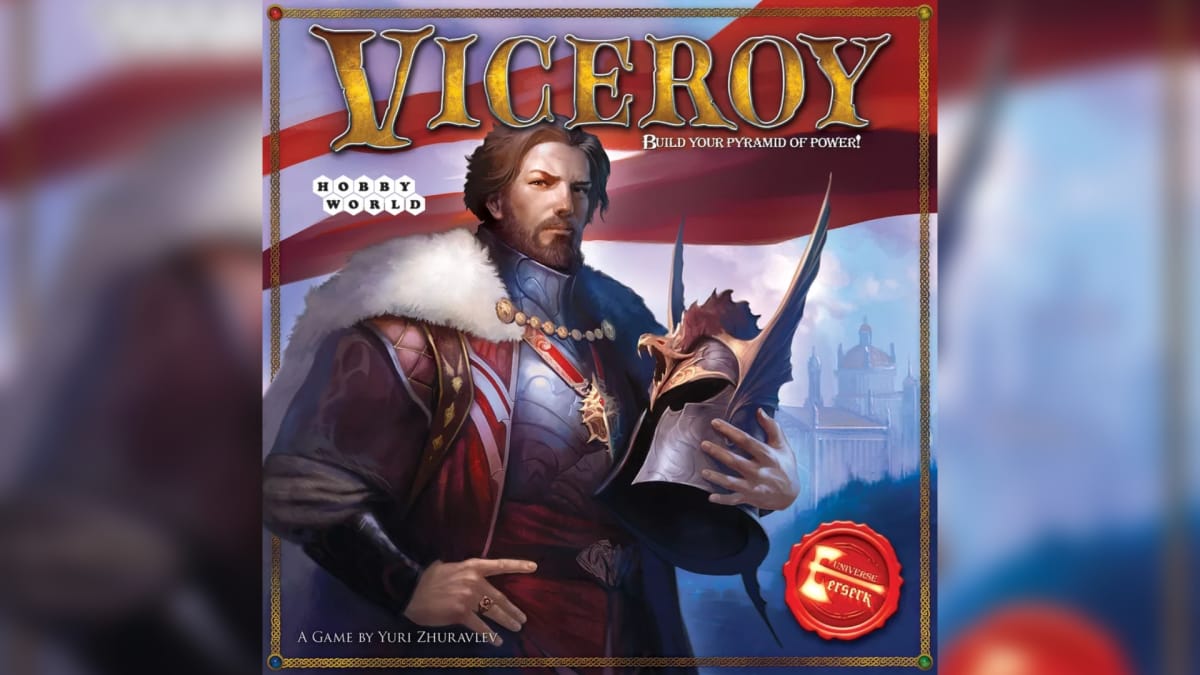Viceroy is an odd duck. It has wonderful plumage and is absolutely beautiful to look at, but when it opens its little duck beak to quack, the sound that escapes is more akin to a structured symphony than any kind of quacking you might expect. Incredibly, despite the disconnect between what you might expect when you look at Viceroy and the experience that you have while playing, the game manages to come together as a whole, and both look and plays beautifully.
What is Viceroy?
Based on Viceroy's art, you wouldn't be out of line if you assumed that it was a fantasy game involving dungeon crawling or a skirmish war game. The art is gorgeous and consistent and gives the impression that the characters shown will engage in battle, intrigue, and political maneuvering. In practice, though, the theme and mechanics have essentially no connection whatsoever. For most games, this would be a major turnoff, but Viceroy's solid and unique mechanics more than make up for this shortcoming.
The game on offer is actually an abstract points-salad style game where players bid on cards and construct them into a two-dimensional pyramid in order to score points based on color matching, set collection, and various other odds and ends. The pyramid-building mechanic is incredibly interesting, especially since each card has varying costs and rewards based on where in the pyramid it will be placed. Deciding which card to go after in the game's Auction phase becomes increasingly difficult as each player's pyramid takes shape and players attempt to acquire cards that will best fit into their strategy.
Phases
Viceroy is played over two phases, the first of which is the Auction phase. Initially, there are four cards laid out on the table for players to bid on. If a card isn't taken in one Auction phase, it will remain on the table in the next round's bidding, increasing the total number of cards on offer. Players use gems, the game's currency, to bid for the cards. The gems are also used in pyramid construction, so players need to carefully manage their gem usage in order to ensure that they can bid on the cards that they want the most. If multiple players bid for the same card, then both players lose their bid, and another Auction occurs. As the game progresses, the competition for certain cards will increase as players formulate plans and strategies and attempt to gather cards that will best fit their growing pyramid.
The Auction phase is also the primary means of acquiring new gems, although to do so, a player must pass their bid and give up their chance to get a new card that round. The balance point between acquiring new cards to add to your pyramid, having enough gems to bid for new cards, and having enough gems to actually construct the card as part of your pyramid mean that careful planning and resource management is vital to player success.
The second phase of Viceroy is the Development phase, which sees all players simultaneously deciding which card to build into their pyramids. During Development, each player simultaneously chooses one card to build into their pyramid, pays the cost, and then receives the reward from the card based on where it was built. The simultaneous play of the Development phase is a saving grace and prevents the game from bogging down as it is in the Development phase, where players really need to concentrate on the construction of their pyramids and plan for future turns.
Building a Pyramid in Viceroy
Viceroy's pyramid-building mechanic is absolutely fantastic. Options and meaningful decisions abound and increase rapidly as the game progresses. It is incredibly satisfying to watch as your pyramid takes shape over the course of the game and even more satisfying when you can successfully build your pyramid in a coherent and strategic manner. Watching the points roll in at the end of the game after successfully acquiring synergistic cards and building them in just the right place in your pyramid is a wonderful feeling, and it can be equally gut-wrenching to see the card that you desperately need to complete your carefully laid plans snatched away by one of your opponents.
A Few Notes on Viceroy
A Note on Player Count
Viceroy can be played by 1 - 4 players and although the solo version feels lacking, it is a nice option to have. As the player count increases, the bidding gets tighter and tension increases. The game even provides an option to artificially tighten the bidding for players who wish to increase the tension of the Auction phase further.
A Note on GameLength
Games of Viceroy typically run about 45 - 60 minutes for my group. Generally, the game time stays consistent as the Development phase is played simultaneously by all players.
A Note on “Chrome”
For the most part, the components of Viceroy are excellent. The cards themselves have a good finish, and the art is bright, lovely, and consistent. The borders of the gem tokens and circular borders on the cards are differentiated based on color to accommodate color-blind players, which is a nice feature. The game includes a score pad which is always a welcome addition.
Is Viceroy Worth Your Money?
Viceroy is a great card game with a wonderfully unique pyramid-building mechanic and has just enough player interaction during the Auction phase to add a little extra layer of tension to the game. The art, while completely disconnected from the mechanics, is stunning, and the pyramids create beautiful mosaics on the table as they come together. Seeing a pyramid come together as the game progresses is extremely satisfying, especially if you can manage to build it in a way that maximizes point income.
The copy of Viceroy used for this review was purchased by the author.
Review Summary
Have a tip, or want to point out something we missed? Leave a Comment or e-mail us at tips@techraptor.net













